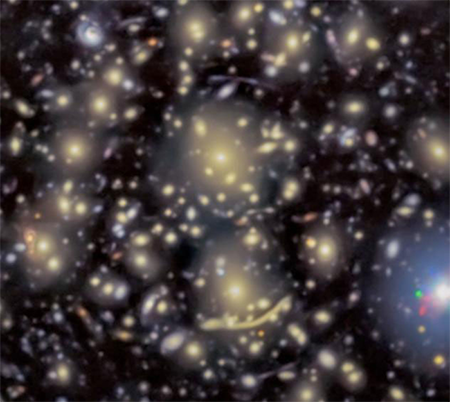| Oct 21, 2021 |
New galaxy images reveal a fitful start to the Universe
|
|
(Nanowerk News) New images have revealed detailed clues about how the first stars and structures were formed in the Universe and suggest the formation of the Galaxy got off to a fitful start.
|
|
An international team of astronomers from the University of Nottingham and Centro de Astrobiología (CAB, CSIC-INTA) used data from the Hubble Space Telescope (HST) and the Gran Telescopio Canarias (GTC), the so-called Frontier Fields, to locate and study some of the smallest faintest galaxies in the nearby universe. This has revealed the formation of the galaxy was likely to be fitful.
|
|
The first results have just been published in the journal Monthly Notices of the Royal Astronomical Society ("Emission Line Galaxies in the SHARDS Frontier Fields I: Candidate Selection and the Discovery of Bursty Ha Emitters").
|
 |
| Image from SHARDS study.
|
|
One of the most interesting questions that astronomers have been trying to answer for decades is how and when the first galaxies formed. Concerning the how, one possibility is that the formation of the first stars within galaxies started at a steady pace, slowly building up a more and more massive system. Another possibility is that the formation was more violent and discontinuous, with intense, but short lived bursts of star formation triggered by events such as mergers and enhanced gas accretion.
|
|
“Galaxy formation can be compared to a car”, explains Pablo G. Pérez-González, one of the co-authors of the paper, affiliated to the Centro de Astrobiología (CAB/CSIC-INTA) in Spain, and principal investigator of the international collaboration behind this study. “The first galaxies might have had a ‘diesel’ star-forming engine, slowly but continuously adding up new stars, without much acceleration and gently turning gas into relatively small stars for long periods of time. Or the formation could have been jerky, with bursts of star formation producing incredibly large stars that disrupt the galaxy and make it cease its activity for a while or even forever. Each scenario is linked to different processes, such as galaxy mergers or the influence of supermassive black holes, and they have an effect on when and how the carbon or oxygen, that are essential for our life, formed.”
|
|
Using the gravitational lensing power of some of the Universe's most massive galaxy clusters with the exceptional GTC data coming from a project entitled the Survey for high-z Red and Dead Sources (SHARDS) the astronomers searched for nearby analogs of the very first galaxies formed in the Universe, so that they could be studied in much more detail.
|
|
Dr Alex Griffiths from the University Nottingham was one of the lead UK researchers on the study, he explains: “Until we have the new James Webb Space telescope, we cannot observe the first galaxies ever formed, they are just too faint. So we looked for similar beasts in the nearby Universe and we dissected them with the most powerful telescopes we currently have.”
|
|
The researchers combined the power of the most advanced telescopes, such as HST and GTC, with the aid of “natural telescopes”. Professor Chris Conselice, from the University of Manchester is a co-author on the study, he said: “Some galaxies live in large groups, what we call clusters, which contain huge amounts of mass in the form of stars, but also gas and dark matter. Their mass is so large that they bend space-time, and act as natural telescopes. We call them gravitational lenses and they allow us to see faint and distant galaxies with enhanced brightness and at a higher spatial resolution”.
|
|
Observations of some of these massive clusters acting as gravitational telescopes is the base of the Frontier Field survey. The study showed that the formation of the galaxy was likely to be stop-start with bursts of activity followed by lulls. Dr Griffiths from the University of Nottingham said: “Our main result is that the start of galaxy formation is fitful, like a jerky car engine, with periods of enhanced star formation followed by sleepy intervals. It is unlikely that galaxy mergers have played a substantial role in the triggering of these bursts of star formation and it is more likely due to alternative causes that enhance gas accretion, we need to search for those alternatives.
|
|
“We were able to find these objects due to the high quality SHARDS data coupled with imaging data from the Hubble Space Telescope to detect hot gas heated by newly formed stars in very small galaxies. This hot gas emits in certain wavelengths, what we call emission lines, just as a neon light. Analysing these emission lines can provide an insight into the formation and evolution of a galaxy.”.
|
|
“The SHARDS Frontier Fields observations carried out with GTC have provided the deepest data ever taken for discovering dwarf galaxies through their emission lines, allowing us to identify systems with recently triggered star formation”, adds Pérez-González, one of the co-authors of the paper and principal investigator of the GTC SHARDS Frontier Fields project.
|

